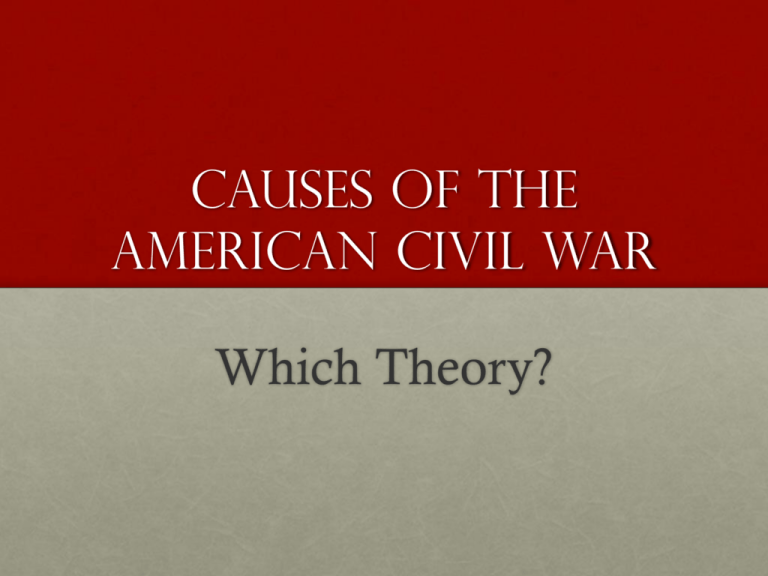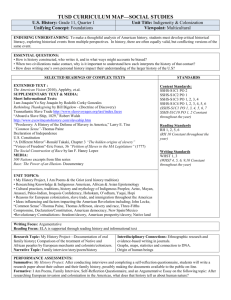File
advertisement

Causes of the American civil war Which Theory? Causes of the American civil war 1. Culture Theory: Clash of civilizations--sections so different conflict was inevitable 2. Western Theory: Struggle to control the West 3. Economic Theory: Clash of labor and economic systems (rich mans’ war, poor man’s fight) 4. Political Theory: States’ rights vs Federal Supremacy 5. Social Theory: Issue and morality of slavery 6. Historical Theory: Establishment of Jamestown and Massachusetts Western Theory • Conflict between North and South to control new acquisitions in the West— Manifest Destiny Texas California Oregon • Politics of the Transcontinental Railroad • Wilmot Proviso and the Expansion of Slavery Culture Theory North saw itself as a region of progress, activity, and action…saw the south as an aristocratic medieval region, evil slave owners A region of cities, commerce, technological advancement—fast-paced, frenetic Hamiltonian? South saw itself as honorable, noble, and followers of the code of chivalry…saw the North as corrupt, full of immigrants, urban, “pasty white mechanics” without honor A rural, agriculturally based society with a feudalistic social structure—deliberate, traditional Jeffersonian? Economic Theory • Two competing regions – industrial North vs. agrarian South Tariff of 1828 and nullification crisis • Free labor vs Slave labor Compromise tariffs of 1832 and 1833 • High tariffs vs low tariffs Walker Tariff of 1846 Western lands: free labor vs slave labor—Free Soil Party Political Theory • Political balance in the Senate • Federal power or states’ rights Kentucky and Virginia Resolutions Nullification and Force Bill Maysville Road Veto and Webster-Hayne Debate “Gag” Rule and Post Office Affair Hartford Convention Bonus Bill • Whigs vs. Democrats Social Theory • Immorality of Slavery • Nat Turner’s Revolt • Northern Abolitionism • Southern defense of the “peculiar” institution • Underground Railroad • Fugitive Slave Law • “personal” liberty laws • Uncle Tom’s Cabin Historical Theory • The founding of Jamestown and Massachusetts • Differences between: • Puritans and Anglicans • New England and Chesapeake demographics economies social structures geographies labor supply • Tobacco, indentured servitude, etc Early Issues • Missouri Compromise • Tariff of Abominations and Nullification Crisis • Turner’s Revolt and Rise of Abolitionism • Texas Question • Gag Rule • Liberty Party Manifest Destiny: 1840s • Oregon Territory • Texas Annexation • California • Free Soil Party and Election of 1848 • Transcontinental Railroad Compromise of 1850 The Law Reaction • Admit California as a free state • Condemned by abolitionists (Young Guard): “higher law” • Ban slave trade in Washington DC • Daniel Webster condemned for “Seventh of March” speech • Stringent Fugitive Slave Law • • Pay Texas $10 million to redefine borders Nine Northern states pass “personal” liberty laws • Nashville Convention: protest the law • Southern “fire-eaters” hint at secession • Whigs lose 1852 election and disappear • Utah and New Mexico territories to use popular sovereignty to settle slavery issue Transcontinental Railroad Proposals Solution Northern Route: Illinois to San Francisco Senator Stephen Douglas (D) from Illinois proposes the Kansas-Nebraska Bill Southern Route: New Orleans to San Diego Gadsden Purchase: $15 million Political “hot potato” Connect West Coast to East Coast Ostend Manifesto Ostend Manifesto • President Pierce in 1853 sent a secret delegation to negotiate with Spain the purchase of Cuba for $130 million • Cuba produced mainly sugar using slave labor • Negotiations took place in Ostend, Belgium • News leaked to the press and a major controversy ensued: Federal govt sided with the “slavocracy” Uncle Toms’ Cabin Harriet Beecher Stowe • From an abolitionist family • Visited Kentucky once • 300,000 copies sold in first year; 2 million sold by 1860 • Popular in Europe • Placed a human face on slavery; also created stereotypes • Harsh Southern reaction; accused North of “wage” slavery "So this is the little lady who made this big war.” –Abraham. Lincoln Kansas-Nebraska Act Sen. Stephen Douglas Proposed northern route of transcontinental railroad through unorganized territory of old Louisiana Purchase Used popular sovereignty to determine slavery in new territories (above 36o 30’) to attract Southern votes Pierce signs bill into law in 1854 Repealed the Missouri Compromise “The Little Giant” Rise of Republican Party 1852 Republican Party Whigs lose Presidency Mix of Free-Soilers, abolitionists, “conscience” Whigs, Liberty Party Whigs are split between “cotton” Whigs and “conscience” Whigs • Favored stronger central government • Stronger banking system • Both Webster and Clay die in 1852 Opposition to the expansion of slavery • Free homesteads in territories • Public education system Whigs disappear • Favored moral reforms • Federal funding of transcontinental railroad and other infrastructure • Protective tariffs • Immigration restrictions Republican Party formed in 1854 in Ripon, Wisconsin “Bleeding” Kansas Conflict • People rush into Kansas: abolitionists and border “ruffians” from Missouri • Slave or free state • Towns sacked and others burned, 200 settlers killed, battles, millions in damages • Lecompton Constitution controversy: prohibited future import of slaves, but did not prohibit slavery Pottawatomie Massacre Sumner-Brooks Affair Charles Sumner Preston Brooks • Abolitionist senator from Massachusetts (Young Guard) • Congressman from South Carolina • Gave speech in Senate” “Crime against Kansas” • Nephew of Sen. Butler • Personal attacked on Sen. Andrew Butler: "a mistress who, though ugly to others, is always lovely to him; though polluted in the sight of the world, is chaste in his sight—I mean, the harlot, Slavery." • Attacked Sumner in the Senate with a cane: beaten to unconsciousness Sumner-Brooks Affair • Sumner severely beaten • Took three years to recover • Massachusetts re-elects Sumner in 1858 • South Carolinians send scores of new canes to Brooks • South Carolina re-elected Brooks Dred Scott Decision Dred Scott • Slave of a physician • Wife (Harriet) and Scott sue for freedom in state courts because they have lived most of their lives in free territory • Used Northwest Ordinances, forbidding slavery, as grounds for freedom Scott v Sandford (1857) • In 7-2 vote, Chief Justice Roger Taney cited the following: Any African descendent, free or slave, could not be a citizen of the U.S. Congress could not regulate slavery in the territories Missouri Compromise is unconstitutional Consequences Dred Scott Decision • Panic of 1857: Only affected the North • South overjoyed • North condemned the “slavocracy” • Slavery free to expand anywhere • Douglas issues Freeport Doctrine: cities and counties could simply not enforce state law permitting slavery LincolnDouglas Debates Senate Race in Illinois in 1858 Seven debates in seven towns Issue: the extension of slavery Sen. Douglas won reelection Launched Lincoln into national prominence Debate: Transcript October, 1859 John Brown’s Raid John Brown leads 20 men on raid at the Federal Arsenal in Harper’s Ferry Goal: Incite a slave insurrection in Virginia Buchanan sends U.S. Marines under Robert E. Lee recapture Federal arsenal: 10 killed including two of Brown’s sons Brown wounded and captured Hung on December 2, 1859 John Brown’s Execution Last words: “I, John Brown, am now quite certain that the crimes of this guilty land will never be purged away but with blood. I had, as I now think, vainly flattered myself that without very much bloodshed it might be done.”






